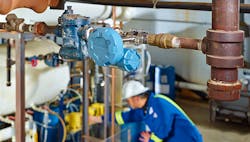Knowledge is first step to sustainability
While sustainability is among the most pressing issues of our time, many process plants are ill equipped to accurately measure the overall impacts of their operations on the environment—much less reduce them. Clearly, the first step toward making progress on the sustainability goals is to measure and understand, in real time, your sustainability performance. But how does one get started on that journey?
Laura Schafer believes that when it comes to sustainable operations, knowledge is power. She’s vice president and general manager, Pervasive Sensing and Connectivity for Emerson, and oversees the company’s growing portfolio of wireless solutions designed to help close the loop on sustainability metrics by first creating granular visibility into the material and energy efficiencies of plant processes and individual pieces of equipment. Only then, she said in a recent interview with Control, can you begin to make measurable progress on your sustainability goals.
Q: Why is it that many plants don’t have a good handle on the sustainability of their operations?
A: Much of the world’s industrial infrastructure has been around for decades, and few new greenfield plants are coming on line, except in some developing regions. Each measurement made in these older plants had to be transmitted back to control rooms via expensive, dedicated wiring—often over long distances. As a result, those plant designs included only those measurement points that were critical for control and safety. Beyond that, few variables were monitored other than those specifically mandated by regulatory requirements.
Vice President/General Manager, Pervasive Sensing and Connectivity, Emerson
Sure, industry has long had a broad appreciation that less waste and higher energy efficiency are good things. But that perspective was primarily motivated by economics, by the cost of fuel, for example. Processing plants simply weren’t instrumented with an eye to modern sustainability metrics such as greenhouse gas emissions or water usage in suddenly drought-stricken areas.
Q: How can organizations begin to better understand the nuances of their plants’ sustainability performance?
A: There are two essential aspects. First is the addition of cost-effective wireless sensors, for getting at key sustainability-related parameters that have previously gone unmeasured. Second are the algorithms and applications that can transform those parameters into actionable alerts and meaningful indicators that are relevant to sustainability.
Practical wireless sensors with a battery life of 10 years or more have been on the market for nearly 15 years now, at an estimated installed cost of 30-60% less than their wired counterparts. In addition to traditional process measurements such as pressure, temperature, flow and level, they can now measure vibrations, sounds and pipe-wall thickness, too.
Q: What’s an example of a sensor/application combination that users can get up and running quickly and easily?
A: Wireless acoustic transmitters such as the Rosemount 708 are both non-intrusive (a snap to install) and are of particular value when it comes to sustainability, as they can be used to verify the proper operation of steam traps [photo] and pressure relief valves—two types of plant devices that can make a significant dent in one’s sustainability performance if malfunctioning. And, since they’re seldom monitored, malfunctions can go undetected for long periods of time, increasing production costs and wasting energy as well as contributing to greenhouse gas emissions.
Rosemount 708 Wireless Acoustic Transmitters work with two of Emerson’s Plantweb Insight applications for Steam Trap Monitoring and Pressure Relief Valve Monitoring. By adding a non-intrusive Rosemount 708 to each of a plant’s steam traps, the Steam Trap Monitoring application gives operators a view into the entire steam system and can alert if any traps are stuck open or blocked. The application eliminates operator rounds, and can show operators the total lost energy costs from leaking steam, as well as calculate incremental greenhouse gas emissions.
Similarly, pressure relief valves are seldom monitored in real time. But if not seated properly, they can leak product into a plant’s flare system—reducing yields while increasing greenhouse gas emissions as well. The Rosemount 708 Wireless Acoustic Transmitter can detect the hiss of escaping product and alert operators to leaks and malfunctions through the Plantweb Insight app, where built-in sustainability algorithms track emissions against performance benchmarks and goals.
Q: Steam traps and pressure relief valves are relatively binary devices in that they tend to work properly, or they don’t. What about monitoring of more complex assets where sustainability performance is more dynamic and can deteriorate over time?
A: Emerson has decades of experience and industry-vetted analytics for two of the most ubiquitous examples of these sorts of assets: heat exchangers and cooling towers. Rather than relying on periodic manual inspections, the Plantweb Insight Heat Exchanger Monitoring app translates fluid flow rates and temperatures into real-time measures of fouling and their impact on energy efficiency.
Meanwhile, the Plantweb Insight Cooling Tower Monitoring application became suddenly very popular in western U.S. where plants are dealing with prolonged drought conditions. A range of instrumentation ranging from pH and conductivity analyzers to temperature sensors and AMS Wireless Vibration Monitors help quantify water usage and evaporation as well as overall cooling tower effectiveness, fan and pump health, and water degradation that can lead to fouling.
Other Emerson sensors and solutions that can impact a facility’s sustainability performance include a wireless corrosion/erosion sensor and Plantweb Insight app that can alert operators to metal loss on the pipe wall that could risk loss of containment. And the Plantweb Insight Connected Lighting app which features pre-programmed or custom control of lighting systems, to keep lights on only when operators are present and simplify maintenance planning. The application can project sustainability impact over a year’s time, and compare energy consumption across multiple locations. Finally, wireless gas sensors can also help to detect the presence of hydrocarbons or other hazardous materials in remote locations so that remediation steps can be taken promptly.
Q: Beyond helping Emerson’s core customer base get started, are there other new frontiers where Emerson technology is making a sustainable difference?
A: Emerson is very active in a broad range of sustainability initiatives, ranging from refrigerants with low or zero global warming impact to low carbon energy sources, such as wind, solar, hydro and nuclear. We’re also involved in carbon capture development efforts, advanced electric grid management techniques, and the coming advent of hydrogen across many industry sectors.
And perhaps most telling, Emerson has committed to reducing greenhouse gas emissions by 20% across our entire global manufacturing footprint and shared service facilities by 2028. We’ve benchmarked our sustainability performance and are taking steps to improve it—and we look forward to helping our customers do the same.


